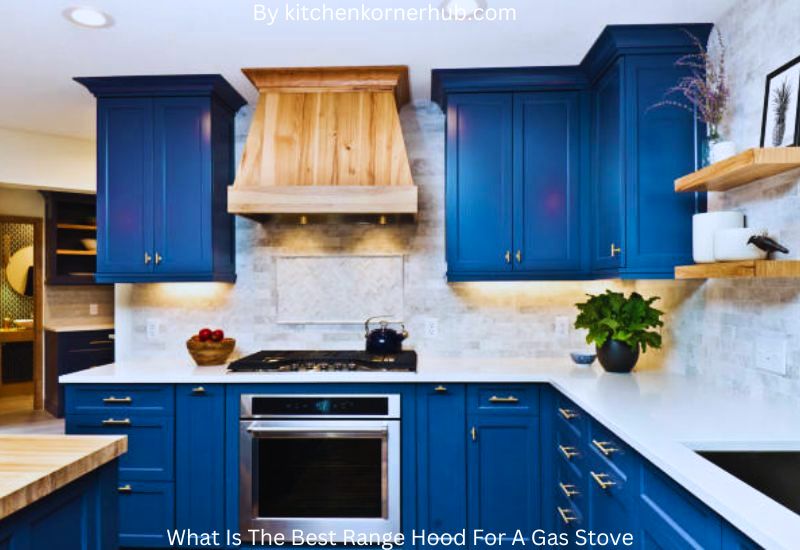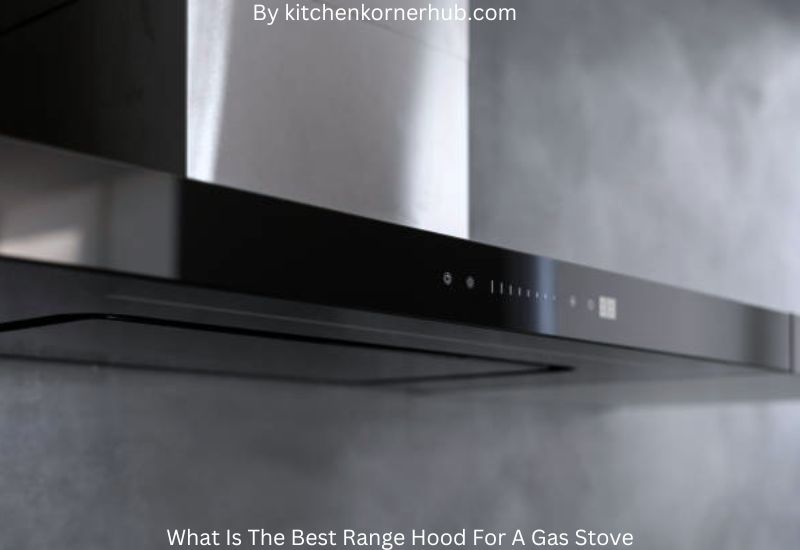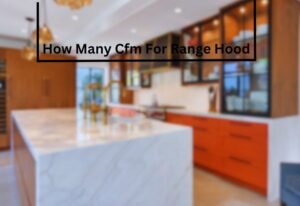If you’re a home chef who loves whipping up sizzling dishes on a gas stove, you know the delicious aromas that fill the air can sometimes linger longer than desired. That’s where a range hood comes to the rescue! A range hood, often referred to as an exhaust hood or vent hood, is an essential kitchen appliance that helps keep your kitchen air clean and free from cooking odors, smoke, and grease.
What Is The Best Range Hood For A Gas Stove? The best range hood for a gas stove would be one with a high extraction rate (CFM), efficient grease and odor removal, and appropriate size for stove coverage. Look for reputable brands like Broan, Zephyr, and KitchenAid, ensuring compatibility with your kitchen setup for optimal ventilation performance.
Choosing the best range hood for your gas stove can greatly enhance your cooking experience while maintaining a fresh and comfortable kitchen environment. With a variety of options available, from wall-mounted to island hoods,it’s important to consider factors like size, ventilation power, noise level, and design that seamlessly fits your kitchen decor. In this guide, we’ll dive into the key features to look for when selecting the perfect range hood for your gas stove, ensuring both effective ventilation and aesthetic harmony in your culinary haven.
Considering Your Kitchen Setup: Choosing the Perfect Range Hood for Your Gas Stove

A range hood is a crucial component of your kitchen, ensuring proper ventilation and keeping the air free from grease, odors, and smoke that arise during cooking.
When selecting the perfect range hood for your gas stove, it’s essential to consider various factors that suit your kitchen setup and cooking style.
Kitchen Layout and Size:
The first step in choosing the right range hood is to assess your kitchen’s layout and size. A larger kitchen may require a more powerful range hood with higher airflow capacity to effectively remove smoke and odors.
On the other hand, a smaller kitchen might benefit from a sleek, compact hood that seamlessly blends into the space.
Ventilation Options:
There are two primary ventilation options: ducted and ductless. Ducted range hoods expel air outside your home through a ventilation duct, while ductless hoods use filters to clean and recirculate the air.
Ducted hoods are more efficient at removing smoke and odors, but they require installation near an exterior wall. Ductless hoods are more flexible in terms of installation but might not be as effective in eliminating strong odors.
Hood Design and Style:
The range hood’s design and style play a significant role in enhancing your kitchen’s aesthetic appeal. There is a wide range of options, from sleek stainless steel hoods to modern glass designs.
Consider the overall theme of your kitchen and choose a hood that complements your decor. Additionally, certain hoods offer customization options, such as LED lighting and different finishes, allowing you to personalize the look according to your preferences.
Additional Features:
Modern range hoods come equipped with various additional features that can enhance their functionality. Some hoods offer adjustable fan speeds, allowing you to customize ventilation power based on your cooking needs.
Others incorporate smart technology, such as sensors that automatically adjust fan speed in response to cooking activity. Heat sensors can also detect high temperatures and activate the hood to ensure safety.
Key Factors to Evaluate When Selecting a Range Hood for Your Gas Stove

Cooking on a gas stove can bring unparalleled control and efficiency to your culinary adventures, but it also necessitates proper ventilation to ensure a healthy cooking environment. A range hood plays a crucial role in removing smoke, odors, and grease particles from the air, enhancing indoor air quality.
However, selecting the right range hood for your gas stove involves careful consideration of several key factors.
Ventilation Power and Sizing:
The effectiveness of a range hood depends on its ventilation power and its compatibility with your gas stove’s size and output. Gas stoves tend to produce more heat and emissions compared to electric stoves, so choosing a hood with adequate cubic feet per minute (CFM) capacity is vital.
A general guideline is to opt for a hood that has at least 100 CFM per linear foot of stove width. This ensures that the range hood can effectively capture and expel the fumes and odors produced during cooking.
Ducted vs. Ductless:
Range hoods come in two primary types: ducted and ductless. Ducted hoods vent air outside your home through ductwork, while ductless hoods use filters to remove impurities and recirculate cleaned air.
For gas stoves, a ducted range hood is generally recommended due to the higher levels of heat and emissions. Ducted hoods effectively remove pollutants from your kitchen, maintaining indoor air quality.
Noise Level:
The noise produced by a range hood can significantly impact your cooking experience. Gas stoves already produce a certain level of noise, and a loud range hood can add to the cacophony.
Look for range hoods with sound-reduction features such as insulated motors and low-noise fans. It’s worth considering models with variable fan speeds, allowing you to adjust the noise level based on your cooking needs.
Design and Aesthetics:
While functionality is paramount, the visual appeal of the range hood should also align with your kitchen’s design. Range hoods come in various styles, from sleek stainless steel to modern glass and even customizable options that can blend seamlessly with your kitchen decor.
Additionally, consider the hood’s lighting features, as adequate illumination of your cooking area is essential for safe and efficient meal preparation.
Maintenance and Filter Type:
Regular maintenance is crucial for the efficient performance of your range hood. Different range hoods use various filter types, such as mesh or baffle filters. Baffle filters, often found in higher-end models, are more effective at trapping grease and require less frequent cleaning compared to mesh filters. Ensuring easy access to the filters and dishwasher-safe components can simplify your cleaning routine
Top Recommendations: Unveiling the Best Range Hood Options for Gas Stoves

When it comes to maintaining a clean and odor-free kitchen environment while cooking on gas stoves, a high-quality range hood becomes an essential kitchen appliance. A range hood effectively extracts smoke, grease, and odors from the air, ensuring that your cooking area remains fresh and well-ventilated.
With a plethora of options available in the market, it’s crucial to choose the right range hood that suits your needs and complements your kitchen’s aesthetics. Here, we present a comprehensive guide to the top range hood recommendations for gas stoves, ensuring you make an informed decision for a more enjoyable cooking experience.
Ducted vs. Ductless Range Hoods: What’s the Difference?
When considering a range hood for your gas stove, one of the primary decisions you’ll need to make is whether to opt for a ducted or ductless model. Ducted range hoods are connected to an external exhaust system, efficiently expelling airborne pollutants outside. On the other hand, ductless range hoods utilize filters to trap grease and odors before recirculating the cleaned air back into the kitchen.
While ducted hoods are more effective in eliminating pollutants, ductless hoods are easier to install and offer more flexibility in placement. Your choice should depend on your kitchen’s layout and your preference for ventilation efficiency.
The Power of CFM: Matching Hood Power to Gas Stove Output
Cubic Feet per Minute (CFM) is a critical factor to consider when selecting a range hood for your gas stove. CFM represents the amount of air a hood can move in a minute, determining how effectively it can remove smoke and odors.
Gas stoves typically generate higher heat output compared to electric stoves, necessitating a range hood with higher CFM ratings. As a general rule, aim for a range hood with a minimum of 1 CFM per 100 BTUs (British Thermal Units) of your gas stove’s output. This ensures optimal performance and a clean cooking environment.
Sleek Designs and Aesthetics: Blending Functionality with Style
Modern range hoods come in a variety of designs, allowing you to seamlessly integrate them into your kitchen’s decor. From stainless steel to glass canopies, there’s a range hood style to match every aesthetic preference. Wall-mounted hoods are popular for their elegant presence, island hoods add a contemporary touch to open kitchens, and under-cabinet hoods offer a more discreet solution. Pay attention to the hood’s size and design to ensure it not only effectively covers your gas stove but also complements the overall look of your kitchen.
Noise Level Considerations: Cooking Comfort and Quiet Operation
While the primary function of a range hood is to eliminate cooking odors and pollutants, the noise it generates can significantly impact your cooking experience. Range hoods with higher CFM ratings might produce more noise due to the increased airflow.
Many manufacturers now focus on creating quieter range hood models equipped with advanced sound insulation technology and variable fan speeds. Look for range hoods with a sone rating, which measures perceived noise level, to ensure a quieter and more comfortable cooking environment.
Smart Features and Technology Integration
In the age of smart homes, even range hoods have embraced technological advancements. Some high-end models offer features like touch-screen controls, remote control operation, and even Wi-Fi connectivity, allowing you to control your range hood with a smartphone app.
Smart range hoods can also adjust fan speeds based on cooking intensity and automatically turn on when they detect excess heat or smoke. While these features come at a premium, they can enhance your cooking experience and streamline your kitchen’s functionality
Efficiency and Performance: Features to Look for in the Ideal Range Hood for Gas Stoves

When it comes to maintaining a clean and comfortable kitchen environment while cooking on a gas stove, selecting the right range hood is essential. A range hood serves as an indispensable tool to eliminate cooking odors, grease, and harmful fumes from the air.
To ensure optimal efficiency and performance, there are several key features to consider when choosing the ideal range hood for gas stoves.
Extraction Capacity and Power
One of the primary factors to assess is the range hood’s extraction capacity, often measured in cubic feet per minute (CFM). For gas stoves, which generate higher levels of heat and potentially more smoke, it’s recommended to opt for a range hood with a higher CFM rating.
A powerful extraction system will effectively capture and remove odors, steam, and grease particles, maintaining a healthier and more comfortable kitchen atmosphere.
Venting Options and Duct Size
Venting options are crucial considerations, as they determine how efficiently the range hood expels air to the outside. There are two main venting methods: ducted and ductless. Ducted systems are generally more efficient as they direct pollutants outdoors.
Additionally, ensure the range hood’s duct size matches the gas stove’s output to prevent restricted airflow and maximize performance.
Adjustable Fan Speeds and Noise Levels
An ideal range hood should offer adjustable fan speeds to cater to varying cooking needs. This feature not only enhances energy efficiency but also minimizes noise levels when high extraction capacity is not required.
Since gas stoves can produce more intense cooking conditions, having control over the fan speed ensures efficient ventilation without excessive noise disruption.
Effective Filtration System
A strong filtration system is pivotal in capturing and containing grease and airborne particles. Baffle filters, mesh filters, and charcoal filters are common options, each with its own benefits.
Baffle filters are particularly effective for gas stoves, as they efficiently trap grease without clogging easily. Regular maintenance and cleaning of filters are essential to maintain the range hood’s performance over time.
Design and Aesthetics
While functionality is paramount, the range hood’s design and aesthetics should also align with your kitchen’s style. Opt for a design that complements your kitchen decor and provides adequate coverage for your stove area.
Some range hoods come equipped with additional lighting features, which not only enhance visibility but also add a touch of ambiance to your cooking space
conclusion
In conclusion, selecting the ideal range hood for a gas stove involves considering both functionality and aesthetics. A powerful ventilation system that effectively removes odors, fumes, and grease is essential for maintaining a clean and safe kitchen environment. Moreover, choosing a hood that complements your kitchen’s design enhances its overall appeal. By evaluating factors such as airflow capacity, noise level, and ease of maintenance, one can make an informed decision tailored to their cooking habits and kitchen layout. Prioritizing quality and suitability ensures a harmonious balance between performance and style in the pursuit of the best range hood for a gas stove.
Frequently asked question(What Is The Best Range Hood For A Gas Stove)
What type of range hood do you need for a gas stove?
Selecting the right range hood for your gas stove is a crucial decision, as it directly impacts the safety and functionality of your kitchen space. When it comes to gas stoves, a range hood with specific features is recommended to effectively address the unique challenges posed by these stoves.
Gas stoves emit a higher amount of heat and combustion byproducts compared to electric stoves. Therefore, it’s essential to opt for a range hood with a higher cubic feet per minute (CFM) rating to effectively capture and remove these pollutants from the air. A higher CFM rating ensures better ventilation and prevents the accumulation of smoke, grease, and potentially harmful gases in your kitchen.
Do you need a special range hood for a gas stove?
Yes, you do need a special range hood designed for a gas stove. Gas stoves produce a mix of combustion byproducts, including carbon monoxide and nitrogen dioxide, in addition to steam, grease, and odors. These byproducts can pose health risks and contribute to poor indoor air quality if not properly ventilated.
To address these concerns, a range hood equipped with a more powerful exhaust system is recommended. Additionally, a range hood with a larger capture area and higher CFM rating is necessary to effectively handle the increased heat output and emissions from gas stoves. This ensures that the harmful substances are promptly removed, maintaining a safe and comfortable cooking environment.
What is the most powerful kind of range hood?
The most powerful type of range hood is the “wall-mounted chimney” or “wall-mounted canopy” hood. These hoods are designed for high-performance ventilation, making them suitable for kitchens with heavy cooking demands, such as those equipped with gas stoves or commercial-grade appliances.
Wall-mounted chimney hoods are characterized by their vertical, chimney-like structure that extends from the cooking surface to the ceiling. This design allows for a larger capture area, efficient airflow, and enhanced extraction of heat, steam, smoke, and odors. Furthermore, these hoods often feature powerful blowers and multiple fan speed options, enabling them to achieve higher CFM ratings and handle even the most intense cooking scenarios.
Which type of kitchen hood is best?
The choice of the best kitchen hood depends on various factors, including your cooking habits, kitchen layout, and aesthetic preferences. However, one of the popular and versatile options is the “under-cabinet” range hood.
Under-cabinet range hoods are mounted beneath a kitchen cabinet or directly against the wall above the cooking range. These hoods are designed to save space while offering efficient ventilation. They come in various styles and sizes to fit different kitchen setups. Under-cabinet hoods also offer a good balance between performance and aesthetics, making them suitable for a wide range of cooking scenarios.
What type of hood is best?
When it comes to choosing the best type of hood, it really depends on your specific needs and preferences. There are a few common types of hoods, each with its own advantages.
First, there’s the traditional under-cabinet hood. These hoods are installed beneath your kitchen cabinets and are great for capturing and removing cooking odors and smoke. They are a popular choice because they are effective and relatively easy to install.
Another option is the wall-mounted hood. These hoods are attached to the wall above your cooking range. They can be a stylish addition to your kitchen and are also effective at removing smoke and odors. If you have a kitchen island, a ceiling-mounted or island hood may be the best choice. These hoods are suspended from the ceiling and are designed to work over an island cooktop.
They provide good coverage and can be a striking focal point in your kitchen. Finally, if you want something more discreet, there are downdraft hoods. These hoods are installed directly into your countertop and rise up when in use. They are less visible when not in use and can be a good option for minimalist kitchen designs. Ultimately, the best type of hood for you depends on your kitchen layout, style preferences, and budget. It’s essential to consider factors like the size of your kitchen, the type of cooking you do, and the aesthetics you want to achieve when making your decision.
Which type of kitchen hood is best?
The best type of kitchen hood largely depends on your specific needs and kitchen layout. There are a few common types of kitchen hoods to consider.
Firstly, the under-cabinet range hood is a popular choice for kitchens with cabinets above the stove. It’s relatively easy to install and doesn’t take up much space. On the other hand, if you have a kitchen island, a ceiling-mounted island hood can be a stylish and effective option.
Wall-mounted range hoods are suitable for kitchens with stove placement against a wall. They offer good ventilation and come in various designs to match your kitchen decor. For those who prefer a discreet option, a downdraft hood can be installed behind or alongside the cooktop and rises when needed, but they might not be as efficient as other types.
Ducted hoods are the most effective at removing cooking odors and smoke, as they vent the air outside your home. However, if ducting isn’t feasible, a ductless or recirculating hood can be an alternative, though it’s less efficient in comparison. Ultimately, the best kitchen hood for you depends on factors like your kitchen layout, budget, and how often you cook. It’s a good idea to consult with a professional or visit a showroom to see the options in person and make an informed decision that suits your needs.




